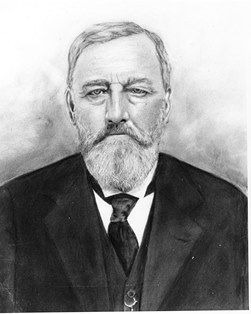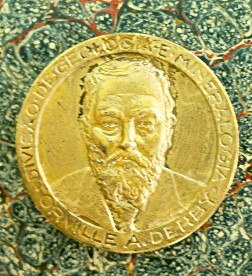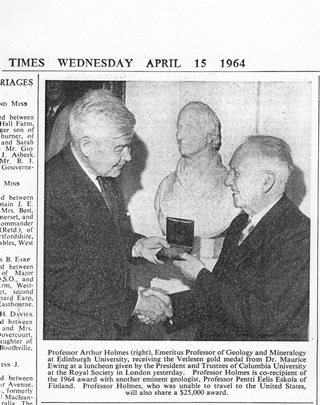Cherry Lewis*, Holmes’s biographer, explores the curious tales surrounding the illustrious geophysicist’s many awards.
 Caught up as I was in all the William Smith celebrations last year, it somewhat passed me by that September 2015 also marked 50 years since the death of Arthur Holmes (1890 - 1965). Many would agree that Holmes was one of the great 20th Century geoscientists, and the 11 medals awarded to him (recently on display in the library at Edinburgh University) are surely testament to this.
Caught up as I was in all the William Smith celebrations last year, it somewhat passed me by that September 2015 also marked 50 years since the death of Arthur Holmes (1890 - 1965). Many would agree that Holmes was one of the great 20th Century geoscientists, and the 11 medals awarded to him (recently on display in the library at Edinburgh University) are surely testament to this.
Many of the medals are no longer awarded and it has been difficult to find out exactly why they were given; but knowing something about the individual after whom the medal was named, and Holmes’s wide-ranging geological acumen, provides some insight.
Picture: Portrait of geologist Orville Derby’s corpse, on which the design of the medal presented to Holmes in 1951, was based. Matchsticks holding his eyelids open have been removed during the retouching process.
1937 – Maurice Lugeon Medal
Maurice Lugeon (1870-1953) was a Swiss geologist and the pioneer of nappe tectonics. Holmes wrote extensively on tectonics and the structure of the continents.
1940 – Murchison Medal, Geological Society of London
First awarded in 1873, the Murchison Medal is given to those who have made a significant contribution to geology by means of a substantial body of research, and for contributions to hard rock studies. Holmes was eminently qualified to receive this medal, writing the first books on the methodology and nomenclature of petrology in the early 1920s. My heavily annotated copy of the latter was once owned by Noel Odell (1890-1987) who, in 1924, was on the ill-fated Everest expedition in which Mallory and Irvine perished during their summit attempt.
1946 – Sederholm Medal, Geological Society of Finland
Johannes Sederholm (1863
–1934) was a petrologist with a particular interest in the Precambrain. In 1911 Holmes spent six months doing fieldwork in Mozambique. This experience was to inform his life’s research, for it was there he recognised geology’s need for a reliable timescale. It also triggered a lifelong interest in the Precambrian and the geology of Africa.
On his return, and two years before the discovery of isotopes, Holmes pioneered the U/Pb technique for dating rocks, creating the first geological timescale based on radiometric dates, and boldly stating that the age of the Earth should be measured in billions, not millions, of years. His frequent correspondence with Sederholm at this time provides a fascinating insight into dating techniques in the 1910s.
1951 – Orville A Derby Medal, Division de Geologia e Mineralogia, Brazil
 Derby (1851 – 1915 - see above) was once regarded as the leading geologist in South America. The medal was created in 1951 by the Brazilian Geological Survey to commemorate the 100th anniversary of his birth (in New York), so Holmes was the first to receive it.
Derby (1851 – 1915 - see above) was once regarded as the leading geologist in South America. The medal was created in 1951 by the Brazilian Geological Survey to commemorate the 100th anniversary of his birth (in New York), so Holmes was the first to receive it.
Derby’s suicide in 1915 caught everyone by surprise and the Survey office realised they had no recent picture of him. Accordingly they sent some men to his hotel room; he was cleaned up, put in a chair, and photographed – his eyes held open with matchsticks, which were later removed in the touch-up process. The likeness of Derby on the medal (left) is from that photograph!
1955 – Foreign Member Academy of Sciences, Institute of France
The French Academy of Sciences was founded in 1666 by Louis XIV to encourage and protect the spirit of French scientific research. Each year the Academy distributes about 80 prizes, of which this was one.
1956 – Penrose Medal, Geological Society of America
The Penrose Medal is the highest honour awarded by the Geological Society of America. It was established in 1927 by R.A.F. Penrose Jr, for ‘outstanding original contributions or achievements that mark a major advance in the science of geology’ – Holmes fitted the bill perfectly. He was a maverick, always thinking outside the box and challenging conventional beliefs. For example, Kinglsey Dunham (Holmes’s first PhD student), remembered Holmes presenting a paper on Africa at the International Geological Congress, held in London in 1948. To everyone’s amazement, using a few dates obtained from Mozambique granites, coupled with his ability to see the ‘big picture’ regarding successive orogenic events, Holmes turned African geology on its head.

1956 – Wollaston Medal, Geological Society of London
The Wollaston Medal is the senior medal and highest award of the Geological Society. It is given to geologists who have had a significant influence by means of a substantial body of excellent research in either or both 'pure' and 'applied' aspects of the science.
Holmes is probably best remembered for his work on continental drift, proposing, in the late 1920s, convection in the mantle as the mechanism that drives tectonic plates around the globe. At the time, continental drift was highly controversial. The ‘anti’ camp was led by Holmes’s great friend, the physicist Harold Jeffreys (Lady Jeffreys told me they used to send each other dirty postcards), who famously argued that drift was a physical impossibility. Holmes, however, was convinced it was the only theory that could explain – and unify – most geological phenomena.
Picture: Holmes (centre) in Jura with European colleagues, 1 May 1930. The picture features in the Principles as an example of concordant topography – the anticline forms a hill.
1957 – Fourmarier Medal, Royal Academy of Belgium
Paul Fourmarier (1877 – 1970) was a Belgian authority on tectonics who specialised in the study of fold structures and cleavage.
1958 – Van Wetenschappen Medal, Royal Dutch Academy of Sciences
This ‘Medal of Science’ has been superseded by the Academy Professor Prize, awarded to researchers between 54 and 59 years of age for exceptional achievement throughout the course of their careers. The Prize is intended as a lifetime achievement award.
1962 – Makdougall Brisbane Medal, Royal Society of Edinburgh
This prize was founded in 1855 by Sir Thomas Makdougall Brisbane and awarded biennially, with preference given to people working in Scotland. It was awarded to Holmes while he was Regius Professor in Geology at Edinburgh University ‘in recognition of your pre-eminent contributions to the fundamental philosphy [sic] of the Earth Sciences’.
1964 – The Vetlesen Prize
 Intended to be the ‘Nobel Prize of the Earth Sciences’, the Vetlesen Prize was awarded to Holmes for his ‘uniquely distinguished achievement’ in the sciences resulting in a clearer understanding of the Earth, its history, or its relations to the universe. Characteristically both modest and forthright in his acceptance letter, Holmes expressed his surprise at being selected ‘for what must surely be the highest distinction in the world for geologists. The surprise was all the greater because I have to confess that I had not even known there was such an award’.
Intended to be the ‘Nobel Prize of the Earth Sciences’, the Vetlesen Prize was awarded to Holmes for his ‘uniquely distinguished achievement’ in the sciences resulting in a clearer understanding of the Earth, its history, or its relations to the universe. Characteristically both modest and forthright in his acceptance letter, Holmes expressed his surprise at being selected ‘for what must surely be the highest distinction in the world for geologists. The surprise was all the greater because I have to confess that I had not even known there was such an award’.
Image: Holmes receives the Vetlesen Prize from Maurice Ewing. Ewing arrived in London only to discover he had left the medal in his office, and had to have it flown over from the States.
Holmes shared the $25,000 prize with his friend the Finnish geologist, Professor Pentti Eskola. The award was administered by Columbia University’s Lamont-Doherty Earth Observatory, but as Holmes was unable to travel to America to receive (due to poor health), a luncheon party was held in his honour at the Royal Society (Holmes became an FRS in 1942). After lunch Maurice Ewing (1906 – 1974) presented Holmes with the gold medal, which had been hastily shipped by air from America when, the day before, Ewing had discovered it he had left it in his office!
In awarding the medal Ewing acknowledged how Holmes’s ‘papers, books and teaching had profoundly influenced the thinking of every modern student of the Earth sciences’. Indeed, Holmes’s greatest legacy to us was his glorious textbook, The Principles of Physical Geology, which so many 20th Century geologists grew up on. I have met people from all over the world who still cherish this work and who tell me it is the reason they became geologists.
Holmes died the following year, in September 1965. A month later the first computer-generated reassembly of the continents 200 million years ago was published by Bullard, Everett and Smith (Phil. Trans. R. Soc. A258: 41−51). This ‘Bullard fit’ supported recently-discovered palaeomagnetic data and finally confirmed that continents do indeed move, and celebrated by Douglas Palmer in the August 2015 issue of this magazine.
* Cherry Lewis is author of The Dating Game: One Man’s Search for the Age of the Earth (Cambridge UP)